P-ICT and teacher education
美国教师教育者信息素养标准研制经验研究

美国教师教育者信息素养标准研制经验研究冀惠宋旭璞摘要提高教师教育者信息素养是促进信息技术与教师教育深度融合的重要途径,对推动教师教育改革和教育信息化具有重要的意义。
在我国教育信息化发展进入“致力于融合与创新”的2.0时代,国内对教师教育者的相关研究中缺少对教师教育者信息素养的关注,但教师教育者的信息素养对教师教育改革有着原点意义。
美国作为较早关注教师教育者的国家之一,自2016年起,就遵循“描绘愿景−开发标准−实施反馈”的逻辑进行了有益的研究与实践,已经研制并使用了具有规范性与引导性的教师教育者信息素养标准,其明确的目标定位、深度融合的理念、技术赋能的原则等均为我国教师教育者信息素养的研究提供了借鉴。
在我国教师教育者信息素养研究及标准制定中,要锚定“深度融合”的导向性,注重教育教学与信息技术“深度融合”中教师教育者的价值;理清路径选择,综合运用理论研究与实证研究;坚守正义立场,明确信息技术的伦理边界。
关键词教师教育者信息技术深度融合信息素养标准作者简介冀惠(通讯作者),首都师范大学教育学院博士生,吕梁学院教育系讲师(北京 100037,吕梁 033000);宋旭璞,上海财经大学高等教育研究所助理研究员(上海 200043)。
中图分类号G4 文献标识码A 文章编号1009-5896(2023)05-0121-12随着教育现代化的推进,我国教育信息化发展进入“致力于融合与创新”的2.0时代,信息素养成为新时代高素质教师的核心素养,①“完善教育信息化标准体系”②与提升教师“利用数字技术”的能力则成为教育研究中的热点问题。
教师教育者作为教师教①教育部关于实施全国中小学教师信息技术应用能力提升工程2.0的意见[EB/OL]. (2019-03-21)[2023-06-03]. https:///srcsite/A10/s7034/201904/t20190402_376493.html.②教育部关于发布《教师数字素养》教育行业标准的通知 [EB/OL]. (2022-12-02)[2023-06-03]. /srcsite/A16/s3342/202302/t20230214_1044634.html.121育的“第一资源”,其信息素养为教育与技术深度融合提供了重要保障,而从教育场域的改革经验来看,结构化的素养标准对素养提升有积极的作用,因此,有必要研制教师教育者信息素养标准以助推教师教育者信息素养的提升乃至教师教育的信息化转型。
第十四章 ICT在教育中的应用
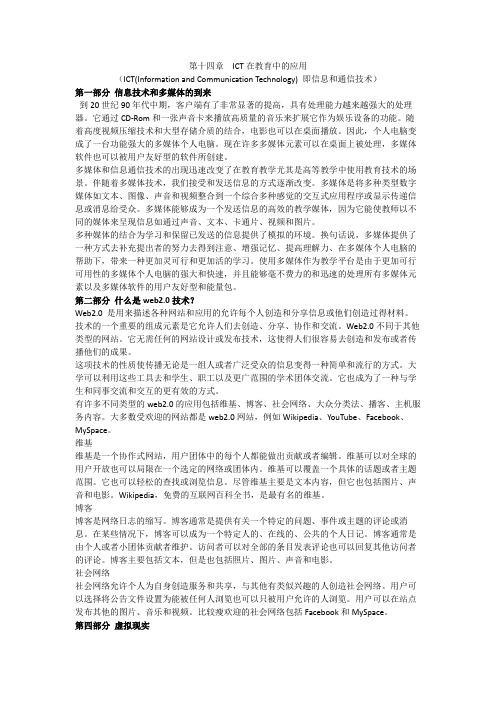
第十四章ICT在教育中的应用(ICT(Information and Communication Technology) 即信息和通信技术)第一部分信息技术和多媒体的到来到20世纪90年代中期,客户端有了非常显著的提高,具有处理能力越来越强大的处理器。
它通过CD-Rom和一张声音卡来播放高质量的音乐来扩展它作为娱乐设备的功能。
随着高度视频压缩技术和大型存储介质的结合,电影也可以在桌面播放。
因此,个人电脑变成了一台功能强大的多媒体个人电脑。
现在许多多媒体元素可以在桌面上被处理,多媒体软件也可以被用户友好型的软件所创建。
多媒体和信息通信技术的出现迅速改变了在教育教学尤其是高等教学中使用教育技术的场景。
伴随着多媒体技术,我们接受和发送信息的方式逐渐改变。
多媒体是将多种类型数字媒体如文本、图像、声音和视频整合到一个综合多种感觉的交互式应用程序或显示传递信息或消息给受众。
多媒体能够成为一个发送信息的高效的教学媒体,因为它能使教师以不同的媒体来呈现信息如通过声音、文本、卡通片、视频和图片。
多种媒体的结合为学习和保留已发送的信息提供了模拟的环境。
换句话说,多媒体提供了一种方式去补充提出者的努力去得到注意、增强记忆、提高理解力、在多媒体个人电脑的帮助下,带来一种更加灵可行和更加活的学习。
使用多媒体作为教学平台是由于更加可行可用性的多媒体个人电脑的强大和快速,并且能够毫不费力的和迅速的处理所有多媒体元素以及多媒体软件的用户友好型和能量包。
第二部分什么是web2.0技术?Web2.0 是用来描述各种网站和应用的允许每个人创造和分享信息或他们创造过得材料。
技术的一个重要的组成元素是它允许人们去创造、分享、协作和交流。
Web2.0不同于其他类型的网站。
它无需任何的网站设计或发布技术,这使得人们很容易去创造和发布或者传播他们的成果。
这项技术的性质使传播无论是一组人或者广泛受众的信息变得一种简单和流行的方式。
大学可以利用这些工具去和学生、职工以及更广范围的学术团体交流。
美国教师教育认证变革探析--基于教育工作者培养质量提升委员会(AAQEP)的分析
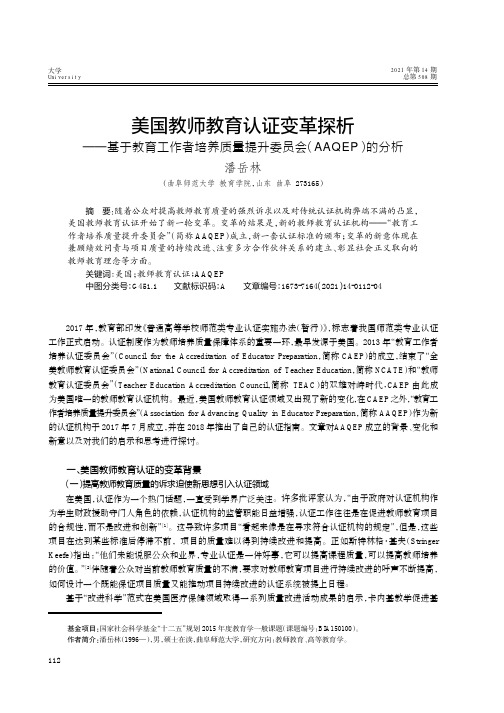
2017年,教育部印发《普通高等学校师范类专业认证实施办法(暂行)》,标志着我国师范类专业认证工作正式启动。
认证制度作为教师培养质量保障体系的重要一环,最早发源于美国。
2013年“教育工作者培养认证委员会”(Council for the Accreditation of Educator Preparation ,简称CAEP )的成立,结束了“全美教师教育认证委员会”(National Council for Accreditation of Teacher Education ,简称NCATE )和“教师教育认证委员会”(Teacher Education Accreditation Council ,简称TEAC )的双雄对峙时代,CAEP 由此成为美国唯一的教师教育认证机构。
最近,美国教师教育认证领域又出现了新的变化,在CAEP 之外,“教育工作者培养质量提升委员会”(Association for Advancing Quality in Educator Preparation ,简称AAQEP )作为新的认证机构于2017年7月成立,并在2018年推出了自己的认证指南。
文章对AAQEP 成立的背景、变化和新意以及对我们的启示和思考进行探讨。
一、美国教师教育认证的变革背景(一)提高教师教育质量的诉求迫使新思想引入认证领域在美国,认证作为一个热门话题,一直受到学界广泛关注。
许多批评家认为,“由于政府对认证机构作为学生财政援助守门人角色的依赖,认证机构的监管职能日益增强,认证工作往往是在促进教师教育项目的合规性,而不是改进和创新”[1]。
这导致许多项目“看起来像是在寻求符合认证机构的规定”,但是,这些项目在达到某些标准后停滞不前,项目的质量难以得到持续改进和提高。
正如斯特林格·基夫(Stringer Keefe )指出:“他们未能说服公众和业界,专业认证是一件好事,它可以提高课程质量,可以提高教师培养的价值。
联合国教科文组织推动教师数字能力发展研究
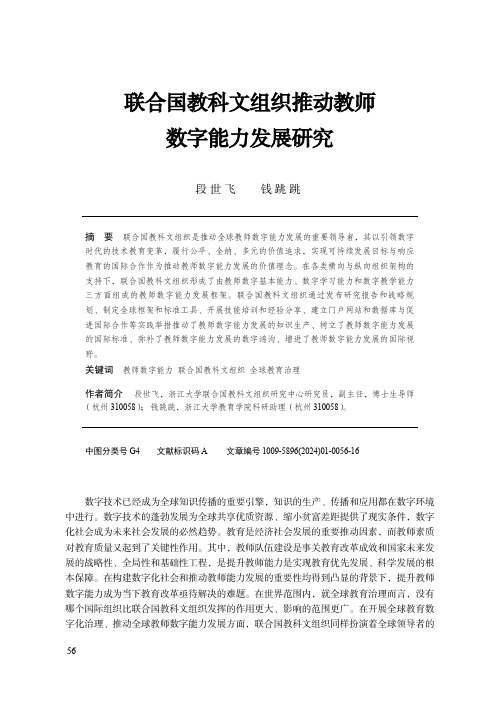
联合国教科文组织推动教师数字能力发展研究段世飞 钱跳跳摘 要 联合国教科文组织是推动全球教师数字能力发展的重要领导者,其以引领数字时代的技术教育变革,履行公平、全纳、多元的价值追求,实现可持续发展目标与响应教育的国际合作作为推动教师数字能力发展的价值理念。
在各类横向与纵向组织架构的支持下,联合国教科文组织形成了由教师数字基本能力、数字学习能力和数字教学能力三方面组成的教师数字能力发展框架。
联合国教科文组织通过发布研究报告和战略规划、制定全球框架和标准工具、开展技能培训和经验分享、建立门户网站和数据库与促进国际合作等实践举措推动了教师数字能力发展的知识生产、树立了教师数字能力发展的国际标准、弥补了教师数字能力发展的数字鸿沟、增进了教师数字能力发展的国际视野。
关键词 教师数字能力联合国教科文组织全球教育治理作者简介 段世飞,浙江大学联合国教科文组织研究中心研究员,副主任,博士生导师(杭州 310058); 钱跳跳,浙江大学教育学院科研助理(杭州 310058)。
中图分类号G4 文献标识码A 文章编号1009-5896(2024)01-0056-16数字技术已经成为全球知识传播的重要引擎,知识的生产、传播和应用都在数字环境中进行。
数字技术的蓬勃发展为全球共享优质资源、缩小贫富差距提供了现实条件,数字化社会成为未来社会发展的必然趋势。
教育是经济社会发展的重要推动因素,而教师素质对教育质量又起到了关键性作用。
其中,教师队伍建设是事关教育改革成效和国家未来发展的战略性、全局性和基础性工程,是提升教师能力是实现教育优先发展、科学发展的根本保障。
在构建数字化社会和推动教师能力发展的重要性均得到凸显的背景下,提升教师数字能力成为当下教育改革亟待解决的难题。
在世界范围内,就全球教育治理而言,没有哪个国际组织比联合国教科文组织发挥的作用更大、影响的范围更广。
在开展全球教育数字化治理、推动全球教师数字能力发展方面,联合国教科文组织同样扮演着全球领导者的联合国教科文组织推动教师数字能力发展研究角色。
The role of ICT in higher education for the 21st century ICT as a change agent for educatio
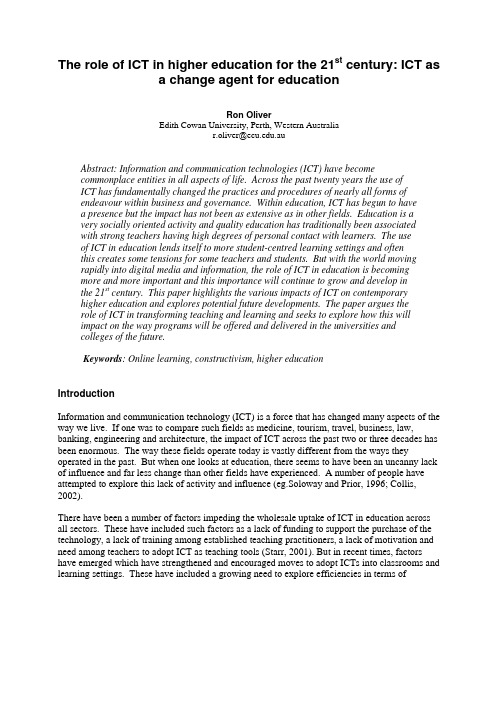
The role of ICT in higher education for the 21st century: ICT asa change agent for educationRon OliverEdith Cowan University, Perth, Western Australiar.oliver@.auAbstract: Information and communication technologies (ICT) have becomecommonplace entities in all aspects of life. Across the past twenty years the use ofICT has fundamentally changed the practices and procedures of nearly all forms ofendeavour within business and governance. Within education, ICT has begun to havea presence but the impact has not been as extensive as in other fields. Education is avery socially oriented activity and quality education has traditionally been associatedwith strong teachers having high degrees of personal contact with learners. The useof ICT in education lends itself to more student-centred learning settings and oftenthis creates some tensions for some teachers and students. But with the world movingrapidly into digital media and information, the role of ICT in education is becomingmore and more important and this importance will continue to grow and develop inthe 21st century. This paper highlights the various impacts of ICT on contemporaryhigher education and explores potential future developments. The paper argues therole of ICT in transforming teaching and learning and seeks to explore how this willimpact on the way programs will be offered and delivered in the universities andcolleges of the future.Keywords: Online learning, constructivism, higher educationIntroductionInformation and communication technology (ICT) is a force that has changed many aspects of the way we live. If one was to compare such fields as medicine, tourism, travel, business, law, banking, engineering and architecture, the impact of ICT across the past two or three decades has been enormous. The way these fields operate today is vastly different from the ways they operated in the past. But when one looks at education, there seems to have been an uncanny lack of influence and far less change than other fields have experienced. A number of people have attempted to explore this lack of activity and influence (eg.Soloway and Prior, 1996; Collis, 2002).There have been a number of factors impeding the wholesale uptake of ICT in education across all sectors. These have included such factors as a lack of funding to support the purchase of the technology, a lack of training among established teaching practitioners, a lack of motivation and need among teachers to adopt ICT as teaching tools (Starr, 2001). But in recent times, factors have emerged which have strengthened and encouraged moves to adopt ICTs into classrooms and learning settings. These have included a growing need to explore efficiencies in terms ofprogram delivery, the opportunities for flexible delivery provided by ICTs (eg. Oliver & Short, 1997); the capacity of technology to provide support for customized educational programs to meet the needs of individual learners (eg. Kennedy & McNaught, 1997); and the growing use of the Internet and WWW as tools for information access and communication (eg. Oliver & Towers, 1999).As we move into the 21st century, these factors and many others are bringing strong forces to bear on the adoption of ICTs in education and contemporary trends suggest we will soon see large scale changes in the way education is planned and delivered as a consequence of the opportunities and affordances of ICT. This paper seeks to explore the likely changes we will see in education as ICT acts as a powerful agent to change many of the educational practices to which we have become accustomed. In particular, the paper will explore the impact both current and emerging information and communication technologies will be likely to have in coming years on what is learned, when and where learning will take place and how the learning will occur.The impact of ICT on what is learnedConventional teaching has emphasised content. For many years course have been written around textbooks. Teachers have taught through lectures and presentations interspersed with tutorials and learning activities designed to consolidate and rehearse the content. Contemporary settings are now favouring curricula that promote competency and performance. Curricula are starting to emphasise capabilities and to be concerned more with how the information will be used than with what the information is.a. competency and performance-based curriculaThe moves to competency and performance-based curricula are well supported and encouraged by emerging instructional technologies (eg. Stephenson, 2001). Such curricula tend to require:•access to a variety of information sources;•access to a variety of information forms and types;•student-centred learning settings based on information access and inquiry;•learning environments centred on problem-centred and inquiry-based activities;•authentic settings and examples; and•teachers as coaches and mentors rather than content experts.Contemporary ICTs are able to provide strong support for all these requirements and there are now many outstanding examples of world class settings for competency and performance-based curricula that make sound use of the affordances of these technologies (eg. Oliver, 2000). For many years, teachers wishing to adopt such curricula have been limited by their resources and tools but with the proliferation and widespread availability of contemporary ICTs, many restrictions and impediments of the past have been removed. And new technologies will continue to drive these forms of learning further. As students and teachers gain access to higher bandwidths, more direct forms of communication and access to sharable resources, the capability to support these quality learning settings will continue to grow.b. information literacyAnother way in which emerging ICTs are impacting on the content of education curricula stems from the ways in which ICTs are dominating so much of contemporary life and work. Already there has emerged a need for educational institutions to ensure that graduates are able to display appropriate levels of information literacy, “the capacity to identify and issue and then to identify, locate and evaluate relevant information in order to engage with it or to solve a problem arising from it” (McCausland, Wache & Berk, 1999, p.2). The drive to promote such developments stems from general moves among institutions to ensure their graduates demonstrate not only skills and knowledge in their subject domains but also general attributes and generic skills. Traditionally generic skills have involved such capabilities as an ability to reason formally, to solve problems, to communicate effectively, to be able to negotiate outcomes, to manage time, project management, and collaboration and teamwork skills. The growing use of ICTs as tools of every day life have seen the pool of generic skills expanded in recent years to include information literacy and it is highly probable that future developments and technology applications will see this set of skills growing even more.The impact of ICT on how students learnJust as technology is influencing and supporting what is being learned in schools and universities, so too is it supporting changes to the way students are learning. Moves from content-centred curricula to competency-based curricula are associated with moves away from teacher-centred forms of delivery to student-centred forms. Through technology-facilitated approaches, contemporary learning settings now encourage students to take responsibility for their own learning .In the past students have become very comfortable to learning through transmissive modes. Students have been trained to let others present to them the information that forms the curriculum. The growing use of ICT as an instructional medium is changing and will likely continue to change many of the strategies employed by both teachers and students in the learning process. The following sections describe particular forms of learning that are gaining prominence in universities and schools worldwide.a. Student-centred learningTechnology has the capacity to promote and encourage the transformation of education from a very teacher directed enterprise to one which supports more student-centred models. Evidence of this today is manifested in:•The proliferation of capability, competency and outcomes focused curricula•Moves towards problem-based learning•Increased use of the Web as an information source, Internet users are able to choose the experts from whom they will learnThe use of ICT in educational settings, by itself acts as a catalyst for change in this domain. ICTs by their very nature are tools that encourage and support independent learning. Students using ICTs for learning purposes become immersed in the process of learning and as more and more students use computers as information sources and cognitive tools (eg. Reeves & Jonassen, 1996), the influence of the technology on supporting how students learn will continue to increase.b. Supporting knowledge constructionThe emergence of ICTs as learning technologies has coincided with a growing awareness and recognition of alternative theories for learning. The theories of learning that hold the greatest sway today are those based on constructivist principles (eg. Duffy & Cunningham, 1996). These principles posit that learning is achieved by the active construction of knowledge supported by various perspectives within meaningful contexts. In constructivist theories, social interactions are seen to play a critical role in the processes of learning and cognition (eg. Vygotsky, 1978).In the past, the conventional process of teaching has revolved around teachers planning and leading students through a series of instructional sequences to achieve a desired learning outcome. Typically these forms of teaching have revolved around the planned transmission of a body of knowledge followed by some forms of interaction with the content as a means to consolidate the knowledge acquisition. Contemporary learning theory is based on the notion that learning is an active process of constructing knowledge rather than acquiring knowledge and that instruction is the process by which this knowledge construction is supported rather than a process of knowledge transmission (Duffy & Cunningham, 1996).The strengths of constructivism lie in its emphasis on learning as a process of personal understanding and the development of meaning in ways which are active and interpretative. In this domain learning is viewed as the construction of meaning rather than as the memorisation of facts (eg. Lebow, 1993; Jonassen & Reeves, 1996). Learning approaches using contemporary ICTs provide many opportunities for constructivist learning through their provision and support for resource-based, student centered settings and by enabling learning to be related to context and to practice (eg. Berge, 1998; Barron, 1998). As mentioned previously, any use of ICT in learning settings can act to support various aspects of knowledge construction and as more and more students employ ICTs in their learning processes, the more pronounced the impact of this will become.The impact of ICT on when and where students learnIn the past educational institutions have provided little choice for students in terms of the method and manner in which programs have been delivered. Students have typically been forced to accept what has been delivered and institutions have tended to be quite staid and traditional in terms of the delivery of their programs. ICT applications provide many options and choices and many institutions are now creating competitive edges for themselves through the choices they are offering students. These choices extend from when students can choose to learn to where they they learn.a. any place learningThe concept of flexibility in the delivery place of educational programs is not new (eg. Moore & Kearsley, 1996). Educational institutions have been offering programs at a distance for many years and there has been a vast amount of research and development associated with establishing effective practices and procedures in off-campus teaching and learning. Use of the technology, however, has extended the scope of this activity and whereas previously off-campus delivery was an option for students who were unable to attend campuses, today, many more students are able to make this choice through technology-facilitated learning settings. The scope and extent of this activity is demonstrated in some of the examples below.•In many instances traditional classroom learning has given way to learning in work-based settings with students able to access courses and programs from their workplace. Theadvantages of education and training at the point of need relate not only to convenience but include cost savings associated with travel and time away from work, and also situation and application of the learning activities within relevant and meaningful contexts.•The communications capabilities of modern technologies provide opportunities for many learners to enroll in courses offered by external institutions rather than those situated locally.These opportunities provide such advantages as extended course offerings and eclectic class cohorts comprised of students of differing backgrounds, cultures and perspectives.•The freedoms of choice provided by programs that can be accessed at any place are also supporting the delivery of programs with units and courses from a variety of institutions, There are now countless ways for students completing undergraduate degrees for example, to study units for a single degree, through a number of different institutions, an activity that provides considerable diversity and choice for students in the programs they complete.b. anytime learningIn concert with geographical flexibility, technology-facilitated educational programs also remove many of the temporal constraints that face learners with special needs (eg. Moore & Kearsley, 1996). Students are starting to appreciate the capability to undertake education anywhere, anytime and any place. This flexibility has heightened the availability of just-in-time learning and provided learning opportunities for many more learners who previously were constrained by other commitments (eg. Young, 2002).•Through online technologies learning has become an activity that is no longer set within programmed schedules and slots. Learners are free to participate in learning activities when time permits and these freedoms have greatly increased the opportunities for many students to participate in formal programs.•The wide variety of technologies that support learning are able to provide asynchronous supports for learning so that the need for real-time participation can be avoided while the advantages of communication and collaboration with other learners is retained.•As well as learning at anytime, teachers are also finding the capabilities of teaching at any time to be opportunistic and able to be used to advantage. Mobile technologies and seamless communications technologies support 24x7 teaching and learning. Choosing how much time will be used within the 24x7 envelope and what periods of time are challenges that will face the educators of the future (eg. Young, 2002).The continued and increased use of ICTs in education in years to come, will serve to increase the temporal and geographical opportunities that are currently experienced. Advancements in learning opportunities tend to be held back by the ICT capabilities of the lowest common denominator, namely the students with the least access to ICT. As ICT access increases among stuednts so too will these opportunities.Emerging IssuesA number of other issues have emerged from the uptake of technology whose impacts have yet to be fully explored. These include changes to the makeup of the teacher pool, changes to the profile of who are the learners in our courses and paramount in all of this, changes in the costing and economics of course delivery.a. expanding the pool of teachersIn the past, the role of teacher in an educational institution was a role given to only highly qualified people. With technology-facilitated learning, there are now opportunities to extend the teaching pool beyond this specialist set to include many more people. The changing role of the teacher has seen increased opportunities for others to participate in the process including workplace trainers, mentors, specialists from the workplace and others. Through the affordances and capabilities of technology, today we have a much expanded pool of teachers with varying roles able to provide support for learners in a variety of flexible settings. This trend seems set to continue and to grow with new ICT developments and applications. And within this changed pool of teachers will come changed responsibilities and skill sets for future teaching involving high levels of ICT and the need for more facilitative than didactic teaching roles (eg. Littlejohn et al., 2002).b. expanding the pool of studentsIn the past, education has been a privilege and an opportunity that often was unavailable to many students whose situation did not fit the mainstream. Through the flexibilities provided by technology, many students who previously were unable to participate in educational activities are now finding opportunities to do so. The pool of students is changing and will continue to change as more and more people who have a need for education and training are able to take advantage of the increased opportunities. Interesting opportunities are now being observed among, for example, school students studying university courses to overcome limitations in their school programs and workers undertaking courses from their desktops.c. the cost of educationTraditional thinking has always been that technology-facilitated learning would provide economies and efficiencies that would see significant reductions in the costs associated with the delivery of educational programs. The costs would come from the ability to create courses with fixed establishment costs, for example technology-based courses, and for which there would be savings in delivery through large scale uptake. We have already seen a number of virtual universities built around technology delivery alone (eg. Jones International University,). The reality is that few institutions have been able to realize these aims for economy. There appear to have been many underestimated costs in such areas as course development and course delivery.The costs associated with the development of high quality technology-facilitated learning materials are quite high. It has found to be more than a matter of repackaging existing materials and large scale reengineering has been found to be necessary with large scale costs. Likewise costs associated with delivery have not been found to diminish as expected. The main reason for this has been the need to maintain a relatively stable student to staff ratio and the expectation of students that they will have access to teachers in their courses and programs. Compared to traditional forms of off-campus learning, technology-facilitated learning has proven to be quite expensive in all areas of consideration, infrastructure, course development and course delivery. We may have to brace ourselves for the advantages and affordances which will improve the quality of education in the near future to also increase components of the cost.Stakeholders and influencesThe ideas that have been discussed in this paper suggest that while ICTs may not have had a large impact to date, their use will grow to play a significant role in many aspects of the design, development and delivery of educational programs in the coming years. The various influences that have been discussed provide examples of an agent that has the capacity to influence education at all levels and hence to be an agent supporting and encouraging considerable change. When the future of education is considered in this way, it is interesting to speculate among the stakeholders, for whom the change will be the greatest. Table 1 lists the principal stakeholders and suggests how the various issues discussed in the paper might influence each. Clearly the stakeholders for whom technology would seem to proffer the most influence and change are the students. So while institutions are pondering how they will be influenced in years to come, whatever the outcomes, the beneficiaries of the activity and change will be the students. This would seem to be the outcome everyone would want to see.Table 1: The influence of ICT on education and its stakeholdersand how much learned learned is learned learningStudentsEmployers x x xTeachers x x x xInstitutions x x x x Government x x x x x xSummary and ConclusionsThis paper has sought to explore the role of ICT in education as we progress into the 21st century. In particular the paper has argued that ICTs have impacted on educational practice in education to date in quite small ways but that the impact will grow considerably in years to come and that ICT will become a strong agent for change among many educational practices. Extrapolating current activities and practices, the continued use and development of ICTs within education will have a strong impact on:•What is learned;•How it is learned;•When and where learning takes place;•Who is learning and who is teaching.The upshot of all this activity is that we should see marked improvements in many areas of educational endeavour. Learning should become more relevant to stakeholders’ needs, learning outcomes should become more deliberate and targeted, and learning opportunities should diversity in what is learned and who is learning. At the same time, quality of programs as measured by fitness for purpose should continue to grow as stakeholder groups find the offerings matched to their needs and expectations.To ensure that the opportunities and advantages are realized, it will be important as it is in every other walk of life to ensure that the educational research and development dollar is sustained so that education at large can learn from within and that experiences and activities in different institutions and sectors can inform and guide others without the continual need for re-invention ofthe wheel. Once again ICTs serve to provide the means for much of this activity to realize the potential it holds.ReferencesBarron, A. (1998). Designing Web-based training. British Journal of Educational Technology, 29(4), 355-371. Berge, Z. (1998). Guiding principles in Web-based instructional design. Education Media International, 35(2), 72-76.Collis, B. (2002). Information technologies for education and training. In Adelsberger, H., Collis, B, & Pawlowski, J. (Eds.) Handbook on Technologies for Information and Training. Berlin: Springer Verlag.Duffy, T., & Cunningham, D. (1996). Constructivism: Implications for the design and delivery of instruction, Handbook of research for educational telecommunications and technology (pp. 170-198).New York: MacMillan.Freeman, M. (1997). Flexibility in access, interactions and assessment: The case for web-based teaching programs.Australian Journal of Educational Technology, 13(1), 23-39.Jonassen, D. & Reeves, T. (1996). Learning with technology: Using computers as cognitive tools. In D. Jonassen (Ed.), Handbook of Research Educational on Educational Communications and Technology (pp 693-719). New York: Macmillan.Kennedy, D. & McNaught, C.(1997). Design elements for interactive multimedia. Australian Journal of Educational Technology, 13(1), 1-22.Laffey J., Tupper, T. & Musser, D. (1998) A computer-mediated support system for project-based learning.Educational Technology Research and Development, 46(1), 73-86.Lebow, D. (1993). Constructivist values for instructional systems design: Five principles toward a new mindset. Educational Technology, Research and Development, 41(3), 4-16.Littlejohn, A., Suckling, C., Campbell, L. & McNicol, D. (2002). The amazingly patient tutor: students’ interactions with an online carbohydrate chemistry course. British Journal of Educational Technology, 33(3), 313-321. McCausland, H.,Wache, D. & Berk, M. (1999). Computer literacy; its implications and outcomes. A case study from the Flexible Learning Centre. University of South Australia.Moore, M. & Kearsley, G. (1996). Distance Education: A Systems View. Belmont, CA: Wadsworth.Oliver, R. & Short, G. (1996). The Western Australian Telecentres Network: A model for enhancing access to education and training in rural areas. International Journal of Educational Telecommunications, 2(4), 311-328. Oliver, R. (2000). Creating Meaningful Contexts for Learning in Web-based Settings. Proceedings of Open Learning 2000. (pp 53-62). Brisbane: Learning Network, Queensland.Oliver, R. & Towers, S. (2000). Benchmarking ICT literacy in tertiary learning settings.In R. Sims, M. O’Reilly & S. Sawkins (Eds). Learning to choose: Choosing to learn. Proceedings of the 17th Annual ASCILITE Conference (pp 381-390). Lismore, NSW: Southern Cross University Press.Soloway, E. & Pryor, A. (1996). The next generation in human-computer interaction. Communications of the ACM, 39(4), 16-18.Starr, L. (2001). Same time this year. [on-line]. Available at /a_tech/tech075.shtml [Accessed July 2002].Stephenson, J., Ed. (2001). Learner-managed learning- an emerging pedagogy for online learning. Teaching and Learning Online: Pedagogies for New Technologies. London, Kogan Page.Young, J. (2002). The 24-hour professor. The Chronicle of Higher Education, 48(38), 31-33.Copyright © 2002 <R. Oliver> The authors assign to the organisers of the HE21 Conference a non-exclusive license to use this document for personal use and in courses of instruction, provided that this article is used in full and this copyright statement is reproduced. The authors also grant a non-exclusive license to the organisers of the HE21 Conference to publish this document on CD-ROM within the HE 21 conference proceedings. Any other usage is prohibited without the express permission of the authors.。
整合技术的学科教学法知识的内涵及其研究现状简述

整合技术的学科教学法知识的内涵及其研究现状简述[摘要]“整合技术的学科教学法知识”,即TPACK(Technological PedagogicalConten tKnowledge)自2005年明确提出以来,在国外受到了教育技术、教师教育、学科教学等领域研究者的广泛关注。
而在我国,TPACK尚处于初步引介的阶段。
截至2010年5月,国内只有少量文献对TPACK的定义及国外研究做了较为详细深入的论述。
鉴于TPACK本身仍是处于发展中的新兴事物,从TPACK概念的演变、发展入手。
简要介绍了当前教师教育、学科教学领域内的TPACK相关研究,力求展现一个较为完整、全面的TPACK概念及其研究现状。
[关键词]TPACK;教师教育:技术整合一、TPAcK概念提出的背景(一)技术对教育产生影响自古以来,每一样新技术(如纸笔、黑板等)的出现都或多或少地对教育领域产生影响。
而在信息技术快速发展、蔓延的今天,这一影响的规模和所产生的效应变得庞大复杂而又变幻莫测。
但迄今为止,技术还未给教育带来如1987年Alfred Bork所预言的变革。
这其中大部分的原因在于,数字技术(用途多样的、不稳定的、功能不透明的)与传统技术(用途特定的、稳定的、功能透明的)的特征有着巨大的差异,大部分数字技术的产生也并非出于教育的目的。
在教师教育领域中,大量的事实证明,让教师单独学习信息技术课程,并不必然导致教师能够在教学中有效地使用技术。
技术与教育的关系,包括技术在教师知识中所扮演的角色,成了一个挥之不去、理络不清但又亟待解决的问题。
(二)TPACK概念的提出在TPACK概念提出之前,已有不少学者注意到技术知识不能独立于教师专业知识而存在,并提出了一些整合了技术的教师专业知识概念(如ICT—reated PCK、e—PCK等)。
尽管字面上表述不同,但这些概念实际上表达了与TPACK 相似的思想。
密西根州立大学的Punya Mishm和Matthew J.Koehler在对教师专业发展项目设计的五项研究中,以LeeShulmall提出的PCK为基础,于2005年首次提出TPACK的概念,并于2006年对TPACK框架中的七个元素进行了详细论述,清晰地勾勒出技术、学科内容、教学法三者之间的关系。
教育常用的英文缩写

教育常用的英文缩写1. 简介在教育领域中,有很多常用的英文缩写词汇。
了解这些缩写词汇对于理解教育文献、研究报告以及参加各种教育会议和研讨会非常重要。
本文档将介绍一些常见的教育英文缩写及其含义。
2. 常见的教育英文缩写- K-12:表示从幼儿园(K)到12年级的基础教育阶段。
K-12:表示从幼儿园(K)到12年级的基础教育阶段。
- EFL:英语作为外语 (English as a Foreign Language)。
EFL:英语作为外语 (English as a Foreign Language)。
- ESL:英语作为第二语言 (English as a Second Language)。
ESL:英语作为第二语言 (English as a Second Language)。
- ELT:英语语言教学 (English Language Teaching)。
ELT:英语语言教学 (English Language Teaching)。
- TESOL:Teaching English to Speakers of Other Languages,涵盖了任何通过英语教授非英语母语人士的教学活动。
TESOL:Teaching English to Speakers of Other Languages,涵盖了任何通过英语教授非英语母语人士的教学活动。
- TOEFL:Test of English as a Foreign Language,外语英语能力测试考试。
TOEFL:Test of English as a Foreign Language,外语英语能力测试考试。
- IELTS:International English Language Testing System,国际英语语言测试系统。
IELTS:International English Language Testing System,国际英语语言测试系统。
“技术-教学-学科知识”(TPACK)研究:最新进展与趋向
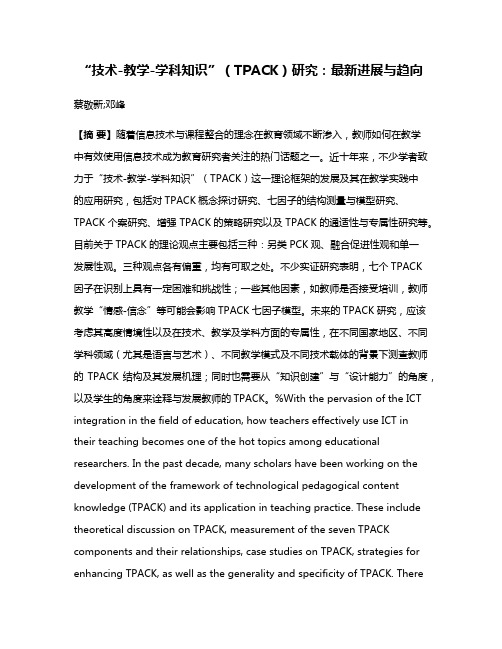
“技术-教学-学科知识”(TPACK)研究:最新进展与趋向蔡敬新;邓峰【摘要】随着信息技术与课程整合的理念在教育领域不断渗入,教师如何在教学中有效使用信息技术成为教育研究者关注的热门话题之一。
近十年来,不少学者致力于“技术-教学-学科知识”(TPACK)这一理论框架的发展及其在教学实践中的应用研究,包括对TPACK概念探讨研究、七因子的结构测量与模型研究、TPACK个案研究、增强TPACK的策略研究以及TPACK的通适性与专属性研究等。
目前关于TPACK的理论观点主要包括三种:另类PCK观、融合促进性观和单一发展性观。
三种观点各有偏重,均有可取之处。
不少实证研究表明,七个TPACK因子在识别上具有一定困难和挑战性;一些其他因素,如教师是否接受培训,教师教学“情感-信念”等可能会影响TPACK七因子模型。
未来的TPACK研究,应该考虑其高度情境性以及在技术、教学及学科方面的专属性,在不同国家地区、不同学科领域(尤其是语言与艺术)、不同教学模式及不同技术载体的背景下测查教师的TPACK结构及其发展机理;同时也需要从“知识创建”与“设计能力”的角度,以及学生的角度来诠释与发展教师的TPACK。
%With the pervasion of the ICT integration in the field of education, how teachers effectively use ICT in their teaching becomes one of the hot topics among educational researchers. In the past decade, many scholars have been working on the development of the framework of technological pedagogical content knowledge (TPACK) and its application in teaching practice. These include theoretical discussion on TPACK, measurement of the seven TPACK components and their relationships, case studies on TPACK, strategies for enhancing TPACK, as well as the generality and specificity of TPACK. Therehave been three main perspectives of TPACK, namely alternative PCK view, integrative-facilitative view, and distinctive-developmental view, each of which has their own focus and merit. Most empirical studies indicate the difficulty and challenge of teasing apart the seven TPACK components. Potential factors include the training of teachers and teachers' affect/belief. Future TPACK research should take into account the highly contextual nature of TPACK and its specificity to technology, pedagogy, and content. More research can investigate how teachers' TPACK may develop within different countries/regions, subject matters (especially Language and Arts), instructional models, and technology-embedded environments. It is also necessary to interpret and develop teachers' TPACK from the lens of knowledge creation and design capacity, and that of students.【期刊名称】《现代远程教育研究》【年(卷),期】2015(000)003【总页数】10页(P9-18)【关键词】TPACK;理论派别;实证探索;研究进展;研究趋向【作者】蔡敬新;邓峰【作者单位】新加坡南洋理工大学新加坡637616;新加坡南洋理工大学新加坡637616【正文语种】中文【中图分类】G434□[新加坡]蔡敬新邓峰随着信息技术与课程整合的理念在教育领域不断渗入,教师如何在教学中有效地使用信息技术成为教育研究者关注的热门话题之一(Deng et al.,2011;Jimoyiannis,2010)。
基于网络模式的教师发展中心建设研究
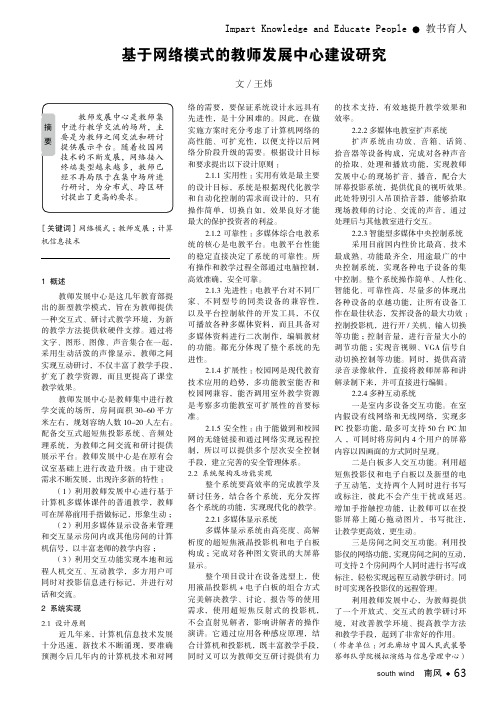
Impart Knowledge and Educate People 教书育人south wind 南风 63[关键词]网络模式;教师发展;计算机信息技术1 概述教师发展中心是这几年教育部提出的新型教学模式,旨在为教师提供一种交互式、研讨式教学环境,为新的教学方法提供软硬件支撑。
通过将文字、图形、图像、声音集合在一起,采用生动活泼的声像显示,教师之间实现互动研讨,不仅丰富了教学手段,扩充了教学资源,而且更提高了课堂教学效果。
教师发展中心是教师集中进行教学交流的场所,房间面积30-60平方米左右,规划容纳人数10-20人左右。
配备交互式超短焦投影系统、音频处理系统,为教师之间交流和研讨提供展示平台。
教师发展中心是在原有会议室基础上进行改造升级。
由于建设需求不断发展,出现许多新的特性:(1)利用教师发展中心进行基于计算机多媒体课件的普通教学,教师可在屏幕前用手指做标记,形象生动;(2)利用多媒体显示设备来管理和交互显示房间内或其他房间的计算机信号,以丰富老师的教学内容;(3)利用交互功能实现本地和远程人机交互、互动教学,多方用户可同时对投影信息进行标记,并进行对话和交流。
2 系统实现2.1 设计原则近几年来,计算机信息技术发展十分迅速,新技术不断涌现,要准确预测今后几年内的计算机技术和对网络的需要,要保证系统设计永远具有先进性,是十分困难的。
因此,在做实施方案时充分考虑了计算机网络的高性能、可扩充性,以便支持以后网络分阶段升级的需要。
根据设计目标和要求提出以下设计原则:2.1.1 实用性:实用有效是最主要的设计目标,系统是根据现代化教学和自动化控制的需求而设计的,只有操作简单,切换自如,效果良好才能最大的保护投资者的利益。
2.1.2 可靠性:多媒体综合电教系统的核心是电教平台。
电教平台性能的稳定直接决定了系统的可靠性。
所有操作和教学过程全部通过电脑控制,高效准确,安全可靠。
2.1.3 先进性:电教平台对不同厂家、不同型号的同类设备的兼容性,以及平台控制软件的开发工具,不仅可播放各种多媒体资料,而且具备对多媒体资料进行二次制作,编辑教材的功能。
智慧教学下高校英语教师应具备的TPACK能力
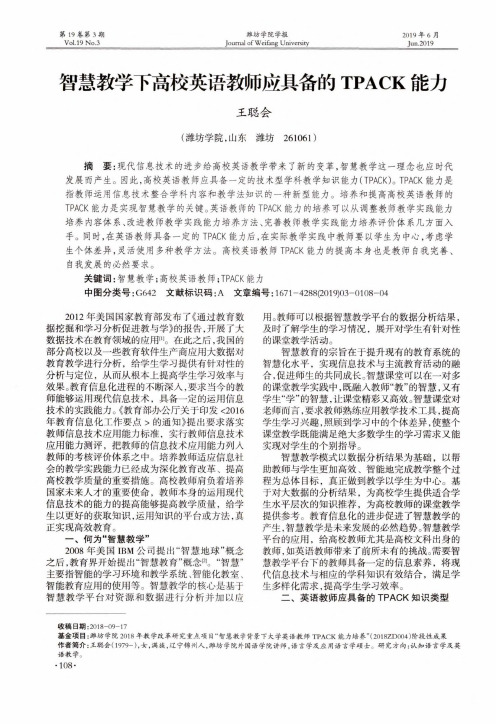
第19卷第3期Vol.19No.3潍坊学院学报Journal of Weifang University2019年6月Jun.2019智慧教学下高校英语教师应具备的TPACK能力王聪会(潍坊学院,山东潍坊261061)摘要:现代信息技术的进步给高校英语教学带来了新的变革,智慧教学这一理念也应时代发展而产生。
因此,高校英语教师应具备一定的技术型学科教学知识能力(TPACK)o TPACK能力是指教师运用信息技术整合学科内容和教学法知识的一种新型能力。
培养和提高高校英语教师的TPACK能力是实现智慧教学的关键。
英语教师的TPACK能力的培养可以从调整教师教学实践能力培养内容体系、改进教师教学实践能力培养方法、完善教师教学实践能力培养评价体系几方面入手。
同时,在英语教师具备一定的TPACK能力后,在实际教学实践中教师要以学生为中心,考虑学生个体差异,灵活使用多种教学方法。
高校英语教师TPACK能力的提高本身也是教师自我完善、自我发展的必然要求。
关键词:智慧教学;高校英语教师汀PACK能力中图分类号:G642文献标识码:A文章编号:1671-4288(2019)03-0108-042012年美国国家教育部发布了《通过教育数据挖掘和学习分析促进教与学》的报告,开展了大数据技术在教育领域的应用叫在此之后,我国的部分高校以及一些教育软件生产商应用大数据对教育教学进行分析,给学生学习提供有针对性的分析与定位,从而从根本上提高学生学习效率与效果。
教育信息化进程的不断深入,要求当今的教师能够运用现代信息技术,具备一定的运用信息技术的实践能力。
《教育部办公厅关于印发<2016年教育信息化工作要点>的通知》提出要求落实教师信息技术应用能力标准,实行教师信息技术应用能力测评,把教师的信息技术应用能力列入教师的考核评价体系之中。
培养教师适应信息社会的教学实践能力已经成为深化教育改革、提高高校教学质量的重要措施。
提升教师ict能力驱动教师专业发展
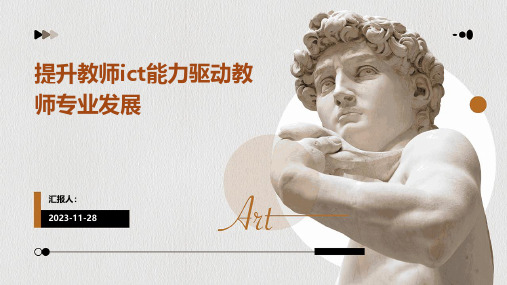
提升教师ict能力驱动教师专业发展汇报人:目录•引言•教师ict能力的现状分析•教师ict能力提升的途径和方法•教师ict能力提升对教师专业发展的影响•结论与展望•参考文献01引言背景介绍随着信息技术的迅速发展,教育领域逐渐融入了计算机技术,推动了教育的数字化转型。
在此背景下,教师的ICT能力成为了教育质量的关键因素之一。
本研究旨在探讨如何提升教师的ICT能力,以推动教师专业发展。
研究目的通过提高教师的ICT能力,可以增强教师的教学能力、创新能力和合作能力,从而提高教育质量,培养更多优秀的人才。
研究意义研究目的和意义02教师ict能力的现状分析•教师ICT能力是指教师在教育教学中运用信息技术工具和资源的能力,包括信息技术与学科教学的整合、设计开发在线课程、管理学习资源、评估学生学习成果等。
0102教师对ICT能力的重视程度不够,缺乏系统的培训和指导,导致在实际教学中无法有效地应用ICT能力。
目前,部分教师ICT能力水平较低,缺乏对信息技术与学科教学有效整合的能力,不能很好地适应信息化时代的教育教学要求。
提升教师ICT能力是推动教育信息化的重要手段,有助于提高教育教学质量和效果。
在信息化时代,学生信息素养的培养和提高离不开教师的引导和示范,因此提升教师ICT能力对于培养学生的信息素养具有重要意义。
提升教师ICT能力有助于推动教育教学改革和创新,促进教师专业发展。
教师ict能力提升的必要性03教师ict能力提升的途径和方法在教师入职前,通过ICT 相关课程的学习,掌握基本的ICT知识和技能。
职前培训在职培训自我学习通过学校或教育部门组织的ICT培训课程,提高教师的ICT能力。
教师通过自主学习,掌握更多的ICT知识和技能,提高自身的ICT能力。
030201通过实践操作,加深对ICT知识和技能的理解和掌握。
实践操作通过与其他教师的交流和合作,分享经验和资源,提高ICT能力。
交流合作通过对自身的教学实践进行反思和总结,发现不足并改进,提高ICT能力。
教师与计算机教学相辅相成的关系英语作文
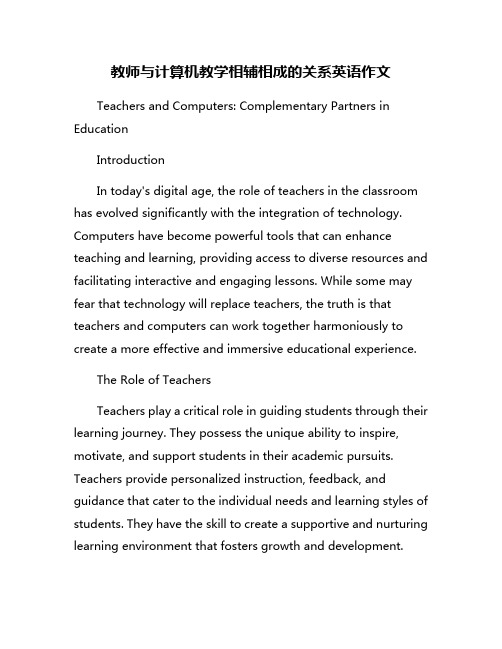
教师与计算机教学相辅相成的关系英语作文Teachers and Computers: Complementary Partners in EducationIntroductionIn today's digital age, the role of teachers in the classroom has evolved significantly with the integration of technology. Computers have become powerful tools that can enhance teaching and learning, providing access to diverse resources and facilitating interactive and engaging lessons. While some may fear that technology will replace teachers, the truth is that teachers and computers can work together harmoniously to create a more effective and immersive educational experience.The Role of TeachersTeachers play a critical role in guiding students through their learning journey. They possess the unique ability to inspire, motivate, and support students in their academic pursuits. Teachers provide personalized instruction, feedback, and guidance that cater to the individual needs and learning styles of students. They have the skill to create a supportive and nurturing learning environment that fosters growth and development.Additionally, teachers serve as role models, imparting knowledge and values that extend beyond the classroom. They teach important life skills such as critical thinking,problem-solving, communication, and collaboration. Teachers also instill a sense of curiosity, creativity, and resilience in their students, preparing them to face the challenges of the future.The Role of ComputersComputers have revolutionized education by providing a vast array of resources and tools that can enhance teaching and learning. With the internet, students have access to a wealth of information and educational content at their fingertips. Computers can facilitate interactive and engaging lessons through multimedia presentations, simulations, and virtual reality experiences. They can also support personalized learning through adaptive learning platforms that cater to individual student needs.Computers enable students to collaborate with peers, engage in online discussions, and participate in project-based learning activities. They can also provide immediate feedback on assessments and track students' progress over time. With educational software and applications, students can practice andreinforce their skills in various subjects, such as math, language arts, and science.The Complementary RelationshipTeachers and computers complement each other in the educational setting, each bringing unique strengths and capabilities to the table. Teachers possess the human touch, empathy, and intuition that computers lack. They are skilled at building relationships, providing emotional support, and fostering a sense of community in the classroom. Teachers can tailor instruction to meet the individual needs of students, adapting their teaching style and strategies to facilitate learning.On the other hand, computers offer efficiency, access to vast resources, and interactive learning experiences that can enhance teaching and engage students. They can provide students with immediate feedback, track progress, and personalize learning experiences based on student performance. Computers can also free up teachers' time by automating routine tasks, such as grading assessments and organizing educational materials.Together, teachers and computers can create a dynamic and effective learning environment that combines the best of both worlds. Teachers can leverage technology to enhance their teaching practices, create interactive and engaging lessons, andsupport personalized learning. Computers can provide valuable resources, tools, and opportunities for students to explore, collaborate, and learn in new and innovative ways.ConclusionIn conclusion, the relationship between teachers and computers is not one of competition but of collaboration. By working together, teachers and computers can create a more effective and immersive educational experience for students. Teachers bring their expertise, empathy, and personalized approach to teaching, while computers offer efficiency, access to resources, and interactive learning experiences. Together, they can empower students to learn, grow, and succeed in a rapidly changing world.。
师范教育协同提质计划英文介绍

师范教育协同提质计划英文介绍The Plan for Collaborative Improvement of Teacher EducationThe Plan for Collaborative Improvement of Teacher Education is a comprehensive program designed to enhance the quality of teacher education across the country. The plan brings together educators, policymakers, and stakeholders to collaborate on a wide range of initiatives aimed at improving the preparation and professional development of teachers.The plan focuses on several key areas, including curriculum development, pedagogical practices, assessment and evaluation, and the integration of technology in teacher education. By addressing these areas, the plan aims to ensure that teachers are equipped with the knowledge, skills, and resources they need to effectively support student learning and development.One of the primary goals of the plan is to promote collaboration among teacher education institutions, K-12 schools, and community organizations. By fosteringpartnerships and sharing best practices, the plan seeks to create a more cohesive and coordinated approach to teacher education. This collaborative effort will help to bridge the gap between theory and practice, and provide teachers with more meaningful and relevant experiences during their training.In addition to promoting collaboration, the plan also emphasizes the importance of continuous improvement and innovation in teacher education. Through ongoing research and evaluation, the plan aims to identify and implement effective strategies for enhancing the quality of teacher preparation programs. This includes exploring new teaching methods, leveraging technology for instructional purposes, and developing new approaches to assessment and evaluation.Furthermore, the plan seeks to address the specific needs of diverse student populations and to promotecultural competence among educators. By integrating diversity and inclusion into teacher education programs, the plan aims to prepare teachers to work effectively with students from all backgrounds and to create inclusive and equitable learning environments.The plan also recognizes the importance of ongoing professional development for teachers at all stages oftheir careers. By providing opportunities for educators to engage in continuous learning and growth, the plan aims to ensure that teachers remain current in their knowledge and skills, and are able to adapt to the evolving needs of students and schools.Overall, the Plan for Collaborative Improvement of Teacher Education represents a significant and ambitious effort to elevate the quality of teacher education in the country. By promoting collaboration, continuous improvement, and a focus on diversity and inclusion, the plan aims to ensure that all students have access to high-quality education and are supported by well-prepared and effective teachers.师范教育协同提质计划师范教育协同提质计划是一个全面的项目,旨在提高全国范围内的师范教育质量。
技术—教学法—内容知识(TPACK)研究议题及其进展
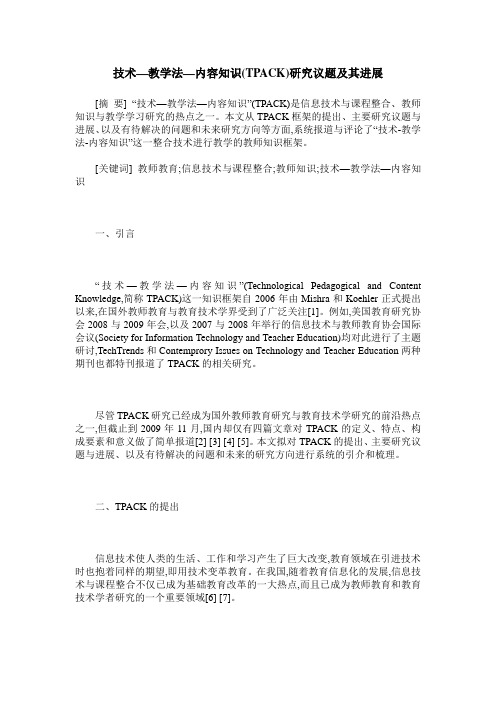
技术—教学法—内容知识(TPACK)研究议题及其进展[摘要] ―技术—教学法—内容知识‖(TPACK)是信息技术与课程整合、教师知识与教学学习研究的热点之一。
本文从TPACK框架的提出、主要研究议题与进展、以及有待解决的问题和未来研究方向等方面,系统报道与评论了―技术-教学法-内容知识‖这一整合技术进行教学的教师知识框架。
[关键词] 教师教育;信息技术与课程整合;教师知识;技术—教学法—内容知识一、引言―技术—教学法—内容知识‖(Technological Pedagogical a nd Content Knowledge,简称TPACK)这一知识框架自2006年由Mishra和Koehler正式提出以来,在国外教师教育与教育技术学界受到了广泛关注[1]。
例如,美国教育研究协会2008与2009年会,以及2007与2008年举行的信息技术与教师教育协会国际会议(Society for Information Technology and Teacher Education)均对此进行了主题研讨,TechTrends和Contemprory Issues on Technology and Teacher Education两种期刊也都特刊报道了TPACK的相关研究。
尽管TPACK研究已经成为国外教师教育研究与教育技术学研究的前沿热点之一,但截止到2009年11月,国内却仅有四篇文章对TPACK的定义、特点、构成要素和意义做了简单报道[2] [3] [4] [5]。
本文拟对TPACK的提出、主要研究议题与进展、以及有待解决的问题和未来的研究方向进行系统的引介和梳理。
二、TPACK的提出信息技术使人类的生活、工作和学习产生了巨大改变,教育领域在引进技术时也抱着同样的期望,即用技术变革教育。
在我国,随着教育信息化的发展,信息技术与课程整合不仅已成为基础教育改革的一大热点,而且已成为教师教育和教育技术学者研究的一个重要领域[6] [7]。
ICT技术在教育中的应用评估
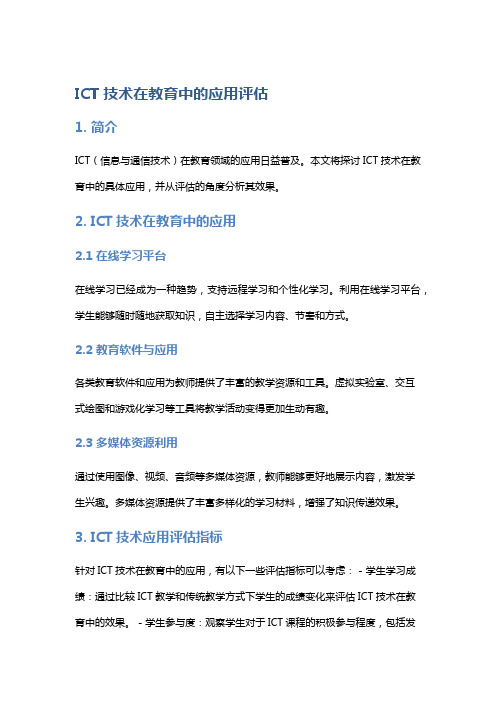
ICT技术在教育中的应用评估1. 简介ICT(信息与通信技术)在教育领域的应用日益普及。
本文将探讨ICT技术在教育中的具体应用,并从评估的角度分析其效果。
2. ICT技术在教育中的应用2.1 在线学习平台在线学习已经成为一种趋势,支持远程学习和个性化学习。
利用在线学习平台,学生能够随时随地获取知识,自主选择学习内容、节奏和方式。
2.2 教育软件与应用各类教育软件和应用为教师提供了丰富的教学资源和工具。
虚拟实验室、交互式绘图和游戏化学习等工具将教学活动变得更加生动有趣。
2.3 多媒体资源利用通过使用图像、视频、音频等多媒体资源,教师能够更好地展示内容,激发学生兴趣。
多媒体资源提供了丰富多样化的学习材料,增强了知识传递效果。
3. ICT技术应用评估指标针对ICT技术在教育中的应用,有以下一些评估指标可以考虑: - 学生学习成绩:通过比较ICT教学和传统教学方式下学生的成绩变化来评估ICT技术在教育中的效果。
- 学生参与度:观察学生对于ICT课程的积极参与程度,包括发言、讨论等,以评估ICT能否激发学生兴趣。
- 教师反馈:收集教师对于ICT技术使用的反馈意见,了解其对于该技术在课堂上的实际效果。
- 教育资源可访问性:衡量学校或机构提供的ICT资源是否易于获取和使用。
4. ICT技术应用评估方法根据以上评估指标,可以使用以下方法进行ICT技术应用的评估:- 实地观察:亲自到课堂上观察ICT技术应用情况,记录学生参与度等数据。
- 调查问卷:向学生和教师发放调查问卷,了解他们对于ICT教学方式的看法和体验。
- 数据分析:收集并分析学生成绩数据,在控制其他因素的情况下比较ICT教学和传统教学方式下的差异。
5. ICT技术应用评估结果分析通过对评估数据进行分析,可以得出ICT技术在教育中的应用效果。
基于评估结果,可以调整教学策略和资源配置,进一步提高ICT技术在教育中的应用效果。
6. 结论ICT技术在教育中的应用已经成为一种不可忽视的趋势,对于改善学习体验和促进个性化学习具有重要作用。
(转)TPCK(TPACK):整合技术的学科教学法知识
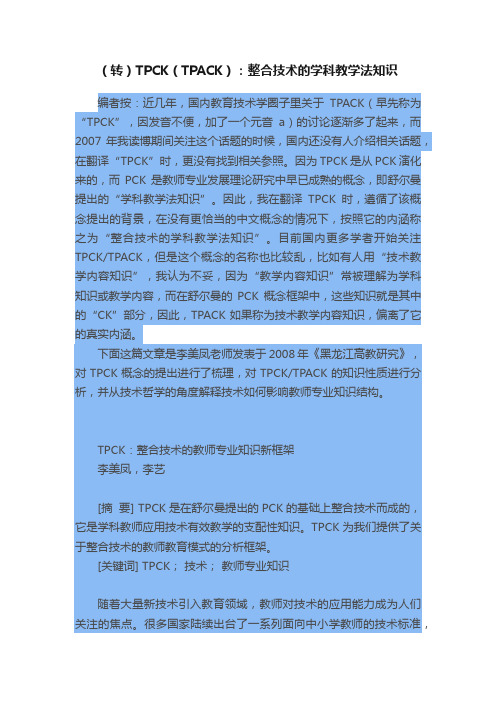
(转)TPCK(TPACK):整合技术的学科教学法知识编者按:近几年,国内教育技术学圈子里关于TPACK(早先称为“TPCK”,因发音不便,加了一个元音a)的讨论逐渐多了起来,而2007年我读博期间关注这个话题的时候,国内还没有人介绍相关话题,在翻译“TPCK”时,更没有找到相关参照。
因为TPCK是从PCK演化来的,而PCK是教师专业发展理论研究中早已成熟的概念,即舒尔曼提出的“学科教学法知识”。
因此,我在翻译TPCK时,遵循了该概念提出的背景,在没有更恰当的中文概念的情况下,按照它的内涵称之为“整合技术的学科教学法知识”。
目前国内更多学者开始关注TPCK/TPACK,但是这个概念的名称也比较乱,比如有人用“技术教学内容知识”,我认为不妥,因为“教学内容知识”常被理解为学科知识或教学内容,而在舒尔曼的PCK概念框架中,这些知识就是其中的“CK”部分,因此,TPACK如果称为技术教学内容知识,偏离了它的真实内涵。
下面这篇文章是李美凤老师发表于2008年《黑龙江高教研究》,对TPCK概念的提出进行了梳理,对TPCK/TPACK的知识性质进行分析,并从技术哲学的角度解释技术如何影响教师专业知识结构。
TPCK:整合技术的教师专业知识新框架李美凤,李艺[摘要] TPCK是在舒尔曼提出的PCK的基础上整合技术而成的,它是学科教师应用技术有效教学的支配性知识。
TPCK为我们提供了关于整合技术的教师教育模式的分析框架。
[关键词] TPCK;技术;教师专业知识随着大量新技术引入教育领域,教师对技术的应用能力成为人们关注的焦点。
很多国家陆续出台了一系列面向中小学教师的技术标准,如美国的教育技术国际委员会(ISTE)制定的《全国教师教育技术能力标准》(NETS-T),美国的教师资格教育国家理事会(NCATE)也将技术纳入了对教师资格的认证标准之中。
新加坡和韩国等国家也都通过全国教育技术标准对教师学习技术提出明确的要求。
- 1、下载文档前请自行甄别文档内容的完整性,平台不提供额外的编辑、内容补充、找答案等附加服务。
- 2、"仅部分预览"的文档,不可在线预览部分如存在完整性等问题,可反馈申请退款(可完整预览的文档不适用该条件!)。
- 3、如文档侵犯您的权益,请联系客服反馈,我们会尽快为您处理(人工客服工作时间:9:00-18:30)。
ABSTRACT The professional development of beginning and experienced teachers has been widely recognised as a key component in the integration of information and communications technologies (ICT) into teaching and learning activities in Australian schools. Many initiatives have been taken, particularly since the mid-1990s, to assist beginning and experienced teachers to use ICT to increase learning opportunities, enhance learning activities, and improve learning outcomes for students. Some of the approaches taken to familiarise teachers about ICT are outlined here, using case studies of ‘good practice’ to illustrate key features. Other approaches focusing on learning with, rather than about new technology, are also noted.
The publisher does not give any warranty express or implied or make any representation that the contents will be complete or accurate or up to date. The accuracy of any instructions, formulae and drug doses should be independently verified with primary sources. The publisher shall not be liable for any loss, actions, claims, proceedings, demand or costs or damages whatsoever or howsoever caused arising directly or indirectly in connection with or arising out of the use of this material.
Downloaded At: 14:10 16 June 2008
Technology, Pedagogy and Education, Vol. 12, No. 1, 2003
Information and Communications Technologies and Teacher Education in Australia
Technology, Pedagogy and Education
Publication details, including instructions for authors and subscription information: /smpp/title~content=t716100724
Information and Communications Technologies, Teacher Professional Development and Initial Teacher Education in Australia Australian government reports have recognised that advances in information and communications technologies (ICT) need to become a part of the knowledge and skills imparted to young people in an increasingly complex world. The National Goals for Schooling, adopted by all state, territory and commonwealth ministers of education in August 1999, state that students leaving school should ‘be confident, creative and productive users of new technologies, particularly information and communication technologies, and understand the impact of those technologies on society’ (Ministerial Council on Education, Employment, Training & Youth Affairs, 1999, p. 2). The national goals also recognise the importance of improved ‘student outcomes’ from schooling, the provision of ‘high-quality schooling’ in achieving agreed goals and the need, if schooling is to be considered ‘socially just’, of providing ‘equitable access’ to education, including students located in remote geographical locations. Government reports have also emphasised that improving access, quality and outcomes is highly dependent on quality teaching. A federal government report titled Teachers for the 21st Century – making the difference recognised that ‘education of the highest quality requires
This article maybe used for research, teaching and private study purposes. Any substantial or systematic reproduction, re-distribution, re-selling, loan or sub-licensing, systematic supply or distribution in any form to anyone is expressly forbid 14:10 16 June 2008
John Pearson
teachers of the highest quality’ (Department of Education, Science and Training, 2000, p. 1), and identified information technology as one of the ‘key priority areas’ for funding professional development activities for teachers. Another report, Learning in an Online World, prepared for state, territory and federal education ministers, also accorded the educational uses of ICT a high priority in professional development for experienced teachers (Ministerial Council on Education, Employment, Training & Youth Affairs, 2000).
Graduates should have an understanding of and ability to use appropriate technologies, particularly information technology to facilitate learning; for record keeping and other administrative tasks; and for professional interaction. They should also have a thorough knowledge of how the new learning, information and communication technologies can be used in their particular curriculum levels and areas, including as a means of enhancing interactions between people and as a means of engaging and interrogating sources of information, argument and ideas. They should be able to evaluate software, and develop strategies for managing classrooms that use new technologies. They should be familiar with current information storage and retrieval systems and technologies, and have the capacity to develop competency in new systems and technologies as they emerge. (pp. 13-14)
